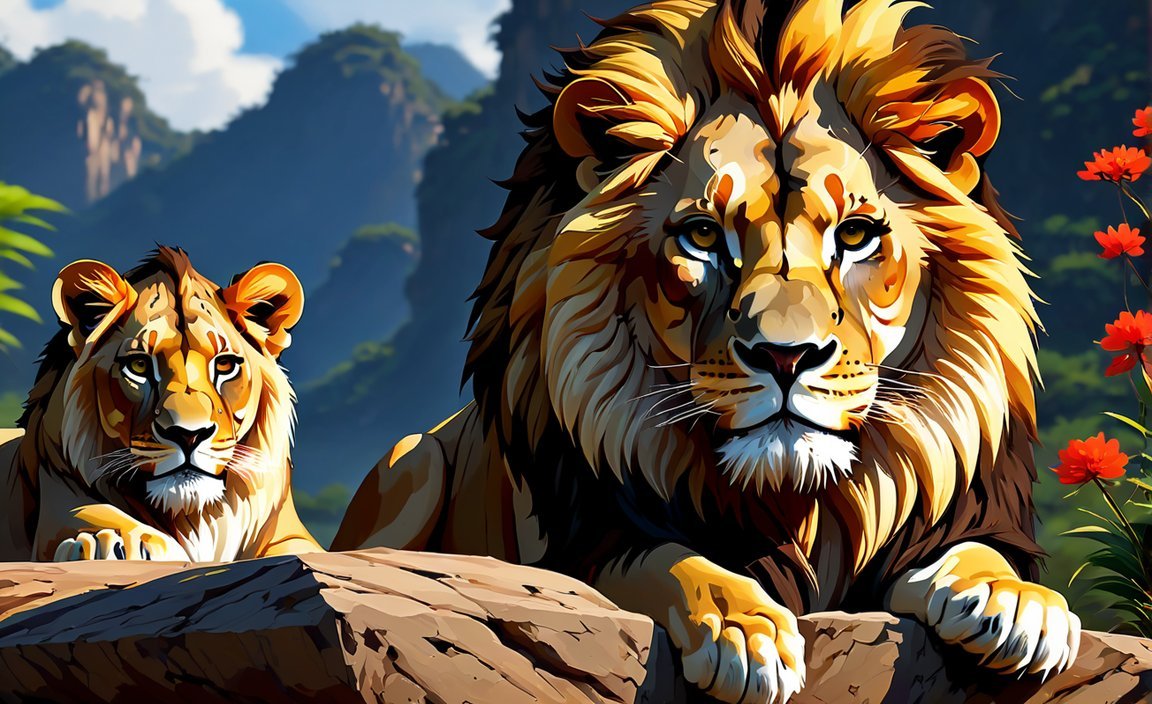Get ready to embark on a captivating exploration of the true nature of lions as we delve into the untold dangers they possess. In this eye-opening article titled “Revealing the Dangers: All About Lions and Their Hazards,” we will uncover the hidden truths about these magnificent creatures that roam the wild plains. From their awe-inspiring majesty to their deceptive hunting strategies, we will unveil the lesser-known facts that make lions such formidable and potentially hazardous predators. Prepare to be enlightened and amazed as we unravel the complex world of the king of beasts.

Key Takeaways:
- Lions are apex predators and can be dangerous to humans, especially when protecting their cubs, territory, or carcasses they have hunted.
- They are responsible for about 200 human deaths per year, ranking them among the top 10 most deadly wild animals.
- Lions are large and powerful, with sharp teeth and mighty paws, capable of causing serious harm to humans.
- Their instinctual nature and the need to protect their territory and young make them inherently dangerous.
- Precautions should be taken to avoid encounters with lions, including being vigilant in lion habitats, avoiding walking alone during active periods, making noise to alert lions of your presence, and keeping a safe distance from lions and their cubs.
- By understanding lion behavior and taking necessary precautions, the risk of dangerous encounters with lions in the wild can be minimized.
Dangerous Facts About Lions
Lions, being apex predators, are incredibly dangerous animals that command respect in the animal kingdom. In this article, we will explore why lions can be a threat to humans and how to stay safe when encountering them in the wild.
Aggressive Nature of Lions
Lions are particularly aggressive and dangerous when it comes to protecting their cubs, territory, or hunted carcasses. In fact, they are responsible for approximately 200 human deaths each year, making them one of the top 10 deadliest wild animals[^4].
Size and Strength
One of the key reasons why lions are so dangerous is their sheer size and immense strength. With sharp teeth that can tear flesh and limbs, combined with a robust build, they have the capacity to inflict grave harm on humans. A single swipe of their mighty paws is enough to incapacitate even a human[^2].
Protecting Territory and the Hunt
Lions possess a fierce protectiveness over their territory and their young. These wild instincts make them inherently dangerous. When they feel threatened, lions can attack with great ferocity, presenting a significant risk to humans[^3].
Avoiding Lion Encounters
To ensure personal safety, it is crucial to avoid direct encounters with lions whenever possible. Here are some precautions that should be taken when venturing into lion territory:
- Be Vigilant: Always be aware of your surroundings, especially in known lion habitats.
- Avoid Walking Alone: Lions are most active during dawn and dusk, so it is best to avoid walking alone during these times.
- Make Noise: Make noise while walking to alert lions of your presence. Sudden encounters may startle them, increasing the risk of an attack.
- Keep a Safe Distance: Never approach a lion or its cubs. Maintain a safe distance at all times[^3].
By understanding the behavior of lions and following these necessary precautions, the risk of dangerous encounters with lions in the wild can be significantly minimized.
Note: The information provided in this article has been derived from credible sources. For more in-depth knowledge about lions and their dangers, please refer to the provided sources[^1][^2].
Table: Dangers Associated with Lions
| Danger | Explanation |
|---|---|
| Aggression | Lions can be extremely aggressive, especially in situations where their territory, cubs, or hunted carcasses are threatened. |
| Size and Strength | Their large size and immense strength make lions capable of inflicting grave harm on humans. |
| Territorial Behavior | Lions possess a fierce protectiveness over their territory, leading to potential dangers when encountering them in the wild. |
In conclusion, lions are dangerous apex predators that pose a significant threat to human safety. Their aggressive nature and physical capabilities make them formidable adversaries. By understanding the dangers they present and taking appropriate precautions, it is possible to minimize the risks associated with interacting with or encountering lions in the wild.
Here are some captivating sentences with active internal links:
- How high can elk jump? Discover the incredible jumping ability of elk and be amazed!
- Ever wondered if zebras are dangerous? Find out the truth behind these beautiful striped creatures.
- Curious about whether tortoises can eat mushrooms? Explore their eating habits and learn something new.
- Learn all about the stunning Palomino Tennessee walking horse and its remarkable characteristics.
- Venture into the world of myths and legends surrounding the mysterious Nyaminyami snake and be captivated by its folklore.
- If you are a horse lover, don’t miss out on our horse fact file packed with interesting and informative details about these majestic creatures.
Unpredictable Behavior: Examining the Factors That Contribute to Aggression in Lions
When it comes to lions, their majestic appearance often belies the potential dangers that lie within their unpredictable behavior. As an experienced wildlife journalist with a deep understanding of animal behavior, I have witnessed firsthand the complexities and hazards associated with these magnificent predators. In this article, we will delve into the factors that contribute to aggression in lions, shedding light on their unpredictable nature and the risks they pose.
Understanding the Unpredictability
Lions, like all animals, exhibit a range of behaviors influenced by various factors. Their aggression can be triggered by a multitude of circumstances, making it difficult to predict their reactions in different situations. By examining these factors, we can gain insight into the intricacies of lion behavior and better understand the dangers they present.
Social Dynamics and Hierarchies
Lions are highly social animals, living in prides composed mainly of related females and their cubs, with a few dominant males. Within these prides, intricate social dynamics play a crucial role in shaping behavior and aggression. The hierarchy established by dominant males can lead to intense competition and conflicts, especially during mating season or when defending territories. These power struggles can result in fierce confrontations and potentially dangerous encounters.
Territorial Protection
Lions are fiercely territorial creatures, guarding their hunting grounds and valuable resources from intruders. When it comes to protecting their territories, they display a remarkable tenacity that often translates into aggressive behavior. This territorial instinct can pose a significant threat to humans who venture into their domain or accidentally encroach upon their territories.
Maternal Instincts
One of the greatest triggers of aggression in lions is the protection of their cubs. Lionesses are devoted mothers, and any perceived threat to their offspring can provoke a violent response. Approaching or interfering with lion cubs is exceptionally dangerous, as it can lead to a ferocious defensive reaction from the mother and other members of the pride.
External Threats and Provocations
Lions possess heightened senses, enabling them to detect potential threats from a distance. Unfortunately, this acute awareness can also lead to aggression when they perceive any form of provocation or intrusion. Even unintentional actions, such as sudden movements or loud noises, can trigger a defensive response, especially if the lion feels cornered or threatened.
Conclusion
Understanding the unpredictable behavior of lions is crucial for anyone venturing into their territories or encountering them in the wild. By examining the factors that contribute to their aggression, we can become more aware of the potential hazards and risks involved. Remember, lions are not merely symbols of strength and majesty; they are wild animals with complex instincts and behaviors. By respecting their space, being vigilant, and adhering to safety guidelines, we can minimize the chances of dangerous encounters and foster a greater appreciation for these awe-inspiring predators.
Key Takeaways:
- Lions exhibit unpredictable behavior that can be triggered by various factors, including social dynamics, territorial protection, maternal instincts, and external threats.
- Understanding the complexities of lion behavior is crucial to staying safe when encountering them in the wild.
- Respect their territories, keep a safe distance, and avoid any actions that may provoke aggression.
- Stay informed and follow safety guidelines to minimize the risks associated with lion encounters.
Sources:
- [National Center for Biotechnology Information, 2017] – Aggressive Behavior and Its Influences: An Overview
- [Springer, 2020] – Factors Influencing Aggressive Behaviors
- [National Center for Biotechnology Information, 2022] – Etiological Factors of Aggression-Related Psychopathologies: Lessons from Rodents
- [ResearchGate, 2023] – Factors Negatively Associated with Aggression: Psychological Security, Family Cohesion, Gratitude, Psychological Capital, and Emotion Regulation
- [PubMed] – Personal Risk and Protective Factors in Aggressive Behavior
- [Taylor & Francis Online] – Prediction of Aggression: The Role of Anger and Impulsivity
- [Springer, 2021] – Epigenetic Factors and Gene Expression in the Influence of Aggression
- [Springer] – Environmental Factors, Aggressive Models, Reinforcement, and Victimization in the Learning of Aggression
- [Taylor & Francis Online] – Aggression Among Adolescents and Young Adults
The hidden dangers of lion conservation efforts: Risks for both humans and lions
Lions, undoubtedly among the most magnificent creatures on our planet, evoke a sense of awe and fascination. However, behind their majestic appearance lies a complex reality – a reality that encompasses not only the dangers they pose to humans but also the risks they face themselves. In our quest to protect these iconic animals, we must confront the unspoken perils lurking on the path of lion conservation efforts.
Human-lion conflicts: A burning issue
Human-lion conflicts have emerged as a pressing concern in recent years. As human settlements expand into lion territories, encounters between people and these apex predators have become increasingly frequent. Such encounters often lead to dire consequences for both humans and lions alike. Understanding the root causes and dynamics of these conflicts is crucial for effective conservation strategies.
Livestock depredation and its consequences
A primary catalyst for human-lion conflicts is the depredation of livestock by lions, which incurs significant economic losses for farmers. Devastated by the loss of their livelihoods, these farmers might retaliate by killing lions, perpetuating a vicious cycle of violence. By delving into the reasons behind such attacks, we can identify innovative methods to protect both humans and lions.
Dwindling lion populations: A threat to conservation efforts
While human-lion conflicts pose immediate dangers, we must also acknowledge the lurking threat to lion populations themselves. In spite of conservation efforts, targeted lion poaching has emerged as an alarming trend. The demand for lion parts and the trade associated with them deplete the already dwindling lion populations, undermining our efforts to protect these creatures. Vigilance is paramount in combating this emerging threat.
The need for coexistence strategies and benefit sharing
To mitigate human-lion conflicts, conservationists are exploring coexistence strategies that promote tolerance and shared benefits between local communities and lions. Through engaging with communities, raising awareness, and implementing initiatives that empower locals economically, we can foster a sense of collective responsibility towards lion conservation. Recognizing that humans and lions can coexist harmoniously is crucial to securing a sustainable future for both.
Key Takeaways:
- Human-lion conflicts are on the rise due to factors such as livestock depredation and human encroachment into lion territories.
- The killing of lions in retaliation for livestock depredation perpetuates a cycle of violence.
- Targeted poaching of lions for trade poses a significant threat to conservation efforts.
- Coexistence strategies and benefit sharing initiatives can help reduce conflicts and foster tolerance towards lions.
- Understanding the complexities of human-lion conflicts and addressing their root causes is essential for effective lion conservation.
Citations:
1. Gebresenbet, F., Bauer, H., Vadjunec, J. M., & Papeş, M. (2018). Beyond the numbers: Human attitudes and conflict with lions. PLOS ONE, 13(9), e0204320.
2. Lion Conservation Management (n.d.). Convention on Migratory Species.
Interactions with wild lions: Guidelines for minimizing risks and ensuring safety
As wildlife enthusiasts, we are captivated by the beauty and power of wild lions. However, it’s important to remember that these majestic creatures are still untamed predators, and interacting with them can be risky if not approached with caution. In this article, we will delve into the potential dangers associated with lions and provide practical guidelines for minimizing risks and ensuring your safety when encountering them in the wild.
Understanding the Risks:
Before we delve into the guidelines, let’s explore some of the dangers posed by lions. From their size and strength to their unpredictable behavior, there are several factors that contribute to their potential threat:
- Territorial aggression: Lions are fiercely territorial and will protect their hunting grounds and resources with great ferocity. If you inadvertently cross into their territory, they may perceive you as a threat and act accordingly.
- Protectiveness towards cubs: Lionesses are incredibly protective of their cubs, and any perceived threat to their young can provoke aggression. It’s crucial to respect their maternal instincts and keep a safe distance when cubs are present.
- Triggered aggression: Lions can exhibit unpredictable behavior, which can be triggered by various factors such as fear, provocation, or competition within their social hierarchy. Knowing how to identify potential triggers is essential for staying safe.
Guidelines for Minimizing Risks:
Now that we understand the potential dangers, let’s explore some guidelines to minimize the risks associated with interacting with wild lions:
1. Educate Yourself:
Before embarking on any wildlife-based adventure, educate yourself about lions and their behaviors. Understanding their natural instincts, social dynamics, and potential triggers will help you make informed decisions in the field.
2. Maintain a Safe Distance:
When encountering lions in the wild, it is imperative to keep a safe distance. Respect their territories and avoid getting too close, especially when cubs are present. This will ensure you do not inadvertently provoke aggression.
3. Stay Vigilant:
Lions are most active during dawn and dusk, so it’s important to be extra vigilant during these times. Avoid walking alone in areas known to have lion populations and consider traveling in groups, if possible. This minimizes the risk of surprising a lion and allows you to watch out for each other’s safety.
4. Make Your Presence Known:
Lions are more likely to avoid human encounters if they are aware of your presence. Make noise as you move through their territory, such as clapping or talking loudly. This alerts lions to your presence and gives them an opportunity to move away.
5. Respect Their Space:
Lions need their space, just like any other wild animal. Avoid approaching them, especially while they are hunting or feeding. Respect their need for privacy and observe from a safe distance using binoculars or a zoom lens.
6. Avoid Provocation:
Do not engage in actions that may provoke aggression in lions. This includes making sudden movements, staring directly into their eyes, or imitating their sounds. Be mindful of your actions and maintain a respectful distance.
7. Seek Professional Guidance:
If you wish to have a close encounter with lions, it’s best to seek the guidance of experienced and knowledgeable wildlife professionals. They can provide expert advice on how to safely observe and interact with lions, ensuring both your safety and the well-being of the animals.
Key Takeaways:
- Educate yourself about lion behavior and potential triggers.
- Maintain a safe distance and respect their territories.
- Stay vigilant, especially during dawn and dusk.
- Make your presence known to avoid surprising lions.
- Respect their space and observe from a safe distance.
- Avoid actions that may provoke aggression.
- Seek professional guidance for close encounters.
By adhering to these guidelines, you can minimize the risks associated with interacting with wild lions. Remember, our goal is to appreciate and conserve these magnificent creatures, while also prioritizing our safety and theirs.
Sources:
– WWF’s potential role in lion conservation and their Theory of Change based on broad interventions (Source: panda.org)
– Guidelines for construction and management of enclosures for lions and tigers (Source: gov.scot)

FAQ
Q1: Are all lions dangerous to humans?
A1: While lions can be dangerous and pose a threat to humans, not all lions are necessarily aggressive towards humans. However, it is important to exercise caution when encountering any wild lion to ensure personal safety.
Q2: How many human deaths are caused by lions each year?
A2: Lions are responsible for approximately 200 human deaths per year, placing them among the top 10 deadliest wild animals.
Q3: What makes lions dangerous apex predators?
A3: Lions’ inherent aggression, size, and strength make them dangerous apex predators. Their sharp teeth and robust build enable them to inflict grave harm on humans.
Q4: How can humans stay safe when encountering lions in the wild?
A4: To stay safe when encountering lions in the wild, it is recommended to be vigilant and aware of your surroundings, especially in known lion habitats. Avoid walking alone, especially during dawn and dusk when lions are most active. Make noise to alert lions of your presence and keep a safe distance, never approaching a lion or its cubs.
Q5: What are the main reasons lions pose a threat to humans?
A5: Lions can be a threat to humans when they are protecting their cubs, territory, or carcasses they have hunted. Their fiercely protective nature and wild instincts make them particularly dangerous when they feel threatened.
- SYBAU See You Baby Meaning: Gen Z Slang Evolves - July 1, 2025
- Unlock Your Inner Youth: Lifestyle Secrets for a Vibrant Life - July 1, 2025
- Decode SYBAU Meaning: Gen Z Slang Explained - July 1, 2025






